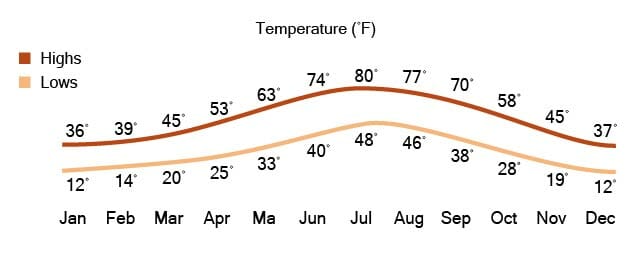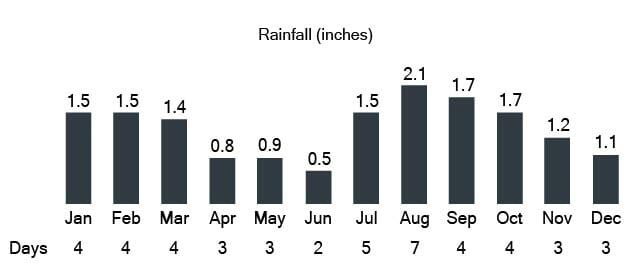


Bryce Canyon National Park Weather
Bryce Canyon is a humid area with very warm summers and no discernible dry season. The landscape of Bryce Canyon is mostly shrublands and forests. The limestone rock formations provide a gorgeous scenic tapestry. While most people think of this area of Utah as being very hot and dry, Bryce Canyon experiences all the seasons and broad changes in temperature. Since the climate can be so variable, it is important to pay close attention to local temperature and outdoor conditions. By using the local forecasted conditions to plan your trip to Bryce Canyon you can be sure that you won’t miss out on important parts of your visit.
Seasons
As if Bryce Canyon could get more incredible, it’s beauty changes with the seasons throughout the year. Each season has so much to offer. There is always something to do or see in Bryce Canyon, so visiting throughout the seasons is a great idea. The seasons give you the opportunity to experience Bryce Canyon with fresh eyes if you visit at different times of year. What you loved in the summer will be completely different during the fall. Plan your trip according to the season you will be visiting and enjoying all that Bryce Canyon has to offer.
Winter
When dealing with the weather in Bryce Canyon, snow is very common during the winter. The temperatures can dip below 0 degrees F, but generally hover around the freezing point.
The combination of higher humidity, snowfall, and flexing temperatures can result in ice accumulation. Ice can make activities quite dangerous, so it is advised to take special care during this time. If you can brave the cold and snow, then you are in for a real treat. The winter is a beautiful time of year in Bryce Canyon.
Spring
Spring brings in beautiful conditions after the harsh canyon winter. As the temperatures increase, so does the rainfall. The mixture of warmer temperatures and increased rain ushers in growth and new beginnings for plants and wildlife.
The flora and fauna are at their most beautiful at this time of year. Plants bloom and provide food and shelter for local wildlife. During spring, animals are mating and bringing new life to the area. If you hope to experience the beauty nature has to offer during your trip, you should consider a trip during the spring.
Summer
The warmest season of all, the summer is a popular time for people to gather at Bryce Canyon. The summer is a wonderful time for all the different activities available in the area.
While the summer is a great time to visit for most, it can be overwhelmingly hot for some. Though the temperature doesn't usually climb past 90 degrees F, there are patches of time where the area experiences unusual heat. If you are worried about it being too hot to handle outside, check the local forecast and plan your trip around the high temperatures.
Fall
For most activities, fall is a perfect time of year to visit Bryce Canyon. The conditions are temperate and cool with only a small chance of rain. The changing leaves provide a beautifully scenic experience along the forest areas. This is an especially great time to visit if you dislike hot or cold extremes. The steady median temperature that fall provides is a sure-fire way to have a great trip.
Average temperatures by month
Throughout the year, temperatures vary greatly. Generally, the temperature doesn't drop below 10 degrees F or rise above 87 degrees F but there are exceptions to the rule. Highs can surpass 100 degrees F and lows have been known to dip down below 0 degrees F. You can usually count on the temperature being close to these averages, though.
January
The average high temperature is 30 degrees F.
The average low temperature is 10 degrees F.
February
The average high temperature is 40 degrees F.
The average low temperature is 12 degrees F.
March
The average high temperature is 43 degrees F.
The average low temperature is 15 degrees F.
April
The average high temperature is 50 degrees F.
The average low temperature is 20 degrees F.
May
The average high temperature is 60 degrees F.
The average low temperature is 28 degrees F.
June
The average high temperature is 72 degrees F.
The average low temperature is 36 degrees F.
July
The average high temperature is 80 degrees F.
The average low temperature is 40 degrees F.
August
The average high temperature is 82 degrees F.
The average low temperature is 52 degrees F.
September
The average high temperature is 71 degrees F.
The average low temperature is 40 degrees F.
October
The average high temperature is 63 degrees F.
The average low temperature is 36 degrees F.
November
The average high temperature is 49 degrees F.
The average low temperature is 20 degrees F.
December
The average high temperature is 34 degrees F.
The average low temperature is 10 degrees F.
Rain
Rain is one of the things that could potentially hinder your plans in Bryce Canyon. Most activities are best done during the drier times so avoiding the rainy season when planning your trip is a great idea. Thunderstorms and light rain are the most common culprits of rain accumulation throughout the year. Rainfall amounts will differ greatly depending on the time of year so please consider this when planning your trip.
August is the wettest time of year in Bryce Canyon. Though there are many days without rain, it is quite common for thunderstorms to move in quickly and go on and off for many days. Occasional flash floods can occur during these rainy times so pay attention to local weather warnings.
June is the driest time of year in Bryce Canyon. While rainfall still occurs, it is much less likely than during August. Planning your trip in June gives you a great chance at avoiding having your plans ruined by rain. Track the local reports closely and reap the benefits of a rain-free vacation.
Snow
Snow is a very common occurrence during the winter season. While the snow doesn't usually accumulate in great amounts, there can be some mild to moderate accumulation, especially in higher elevation.
For most activities in Bryce Canyon, the snow is not the ideal outdoor condition. However, if your goal is to experience scenic beauty winter is a great time to visit Bryce Canyon.
Humidity
Since Bryce Canyon is in an area that is considered to have constant humidity, you can usually count on dealing with it being at least slightly humid during your trip.
The lowest humidity hovers around 8%, though it is usually more humid than this. The least humid month is June which is nice because the heat and humidity do not intersect. The most humid month is February which can lead to increased ice patches. If humidity is a concern for you, following these basic humidity averages while planning your trip should increase your chances of having favorable air quality.
Sunrise & Sunset
Depending on the time of the year, hours in the day can differ greatly. While this difference may not seem significant, it can mean the gap between having a leisurely and long day or having to rush through your activities.
The days are the shortest in January. The average number of daylight hours in January is about 10 hours while June will see about 14 daylight hours. It is important to pay attention to local sunrise and sunset times to ensure you are in a safe location by nightfall. The sunrise and sunset times are included in the local forecasts for Bryce Canyon.
Experience Bryce Canyon
By taking the weather in Bryce Canyon into consideration while planning your trip you can have a better idea of what to expect. It is important to consider when the rainy season is, what the temperature will be, and other important factors. Use this in-depth explanation as a guide to help you decide when to take your vacation to Bryce Canyon. As your trip gets closer, check the local news reports to finalize your plans. No matter what the weather, Bryce Canyon will provide you with a unique and exciting experience.
